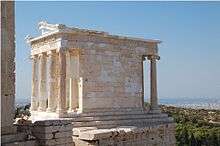Amphiprostyle

Northeast view of the Temple of Athena Nike, a amphiprostyle temple.
In classical architecture, amphiprostyle (from the Greek ἀμφί (amphi), on both sides, and πρόστυλος (prostylos), a portico) denotes a temple with a portico both at the front and the rear.[1] The number of columns never exceeded four in the front and four in the rear. The best-known example is the tetrastyle small Temple of Athena Nike at Athens.
Amphiprostyle temples without columns on the sides may be termed "apteral" (from the Greek απτερος, "wingless": α-, "without" + πτερον, "wing"). The Athena Nike temple is one such example.[2]
See also
Notes
- ↑

- ↑

References

This article is issued from
Wikipedia.
The text is licensed under Creative Commons - Attribution - Sharealike.
Additional terms may apply for the media files.